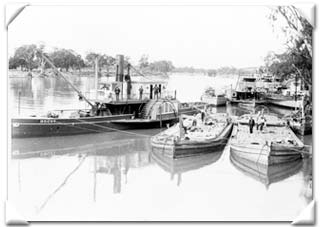
Riverine shipping
River Murray shipping
 Shipping in South Australia was not confined to the sea, but made use of the River Murray, which for much of its length flows through South Australia. The potential of the river for trade was recognized very early in the colony's history by Governor Gawler in 1838. However it was not until 1848 that a new governor, Sir Henry Fox Young, offered a bonus for anyone who was successful in taking two iron hulled steamers up the river to the junction with the Darling River. As a further incentive a jetty was built at Goolwa, and navigation beacons placed on the lower river. It took until August 1853 and the possibility of trade with the Victorian gold fields for anything happen. In that month William Randell and Francis Cadell both had steamers on the river. Their progress upriver turned into a race, at least in the eyes of the press and spectators.
Shipping in South Australia was not confined to the sea, but made use of the River Murray, which for much of its length flows through South Australia. The potential of the river for trade was recognized very early in the colony's history by Governor Gawler in 1838. However it was not until 1848 that a new governor, Sir Henry Fox Young, offered a bonus for anyone who was successful in taking two iron hulled steamers up the river to the junction with the Darling River. As a further incentive a jetty was built at Goolwa, and navigation beacons placed on the lower river. It took until August 1853 and the possibility of trade with the Victorian gold fields for anything happen. In that month William Randell and Francis Cadell both had steamers on the river. Their progress upriver turned into a race, at least in the eyes of the press and spectators.
Their success led to the opening of the river trade, and it rapidly grew. River shipping companies prospered; Goolwa became a major port, and a railway line was opened to Port Elliot on the south coast, to handle the cargoes which came down the river. When Port Elliot proved unsuitable, the railway was extended to Victor Harbor (see Outports). Slowly New South Wales and Victoria realised the quantity of goods that were flowing down the Murrumbidgee, Darling and Murray Rivers and into South Australia. A treaty was signed between the three colonies for the equitable distribution of tariffs; customs houses were established at a number of points along the rivers. Disagreements continued over the decades and were only finally resolved with Federation, and the abolition of internal customs by the new Commonwealth government in 1903.
At the peak of the paddle steamer era on the rivers there were between 200-300 boats operating. Trade flourished. In 1878 the Adelaide-Morgan railway line was opened. This carried cargo from the great north-west bend of the river to Adelaide and the wharfs at its port, bypassing Goolwa. This port did not notice the effects immediately but the following year a road bridge was placed across the river at Murray Bridge, and in 1886 the railway line crossed the bridge and travelled on to the Victorian border. In the next few decades, railways penetrated the mallee country and reached the river towns at Loxton, Waikerie, Paringa, Berri and Renmark, Barmera and Glossop. Rail traffic began to take trade from the paddle steamers.
A major issue for the steamers was the low water at the end of summer - some paddle-steamers were left high and dry as the rivers dried out beneath them. They had no option but to sit and wait for rain upriver to arrive and float them off. This was particularly noticeable during the 'Federation drought' of the late 1890s to 1902. The states came together to discuss 'drought proofing' the river system. An agreement was finally reached in 1915 and the process of locking the river and managing its flow began. The locks were to assist river flows for irrigation purposes and for steam navigation. The agreement was amended in 1924 because of dwindling steamer traffic, as the railways claimed the cargoes. In the end, it was decided in 1934 to further amend the agreement and only 14 locks rather than the original 26, would be built. Paddle-steamers assisted in the construction by transporting rock, gravel and other supplies to the construction site.
Wool was the mainstay of the river trade, but wheat, flour and general stores were regular goods. After the irrigation colonies were established fresh and dried fruit were regularly shipped along the river. Tourism also became a feature of the paddle-steamer trade, as the shipping companies realised there was money to be made from the scenic beauty along the river.
Today trade along the river is non-existent. Road transport, as for many of the maritime ports has taken it away. Tourism remains however with paddle-steamers offering cruises, and a multitude of houseboats providing self-catering holidays on the rivers.
For further information on Riverine Shipping see Downstream: the River Murray in South Australia.Go to The river as a highway
Further reading:
Parsons, Ronald. Ships of the Inland Rivers Gumeracha, Gould Books, 1996








